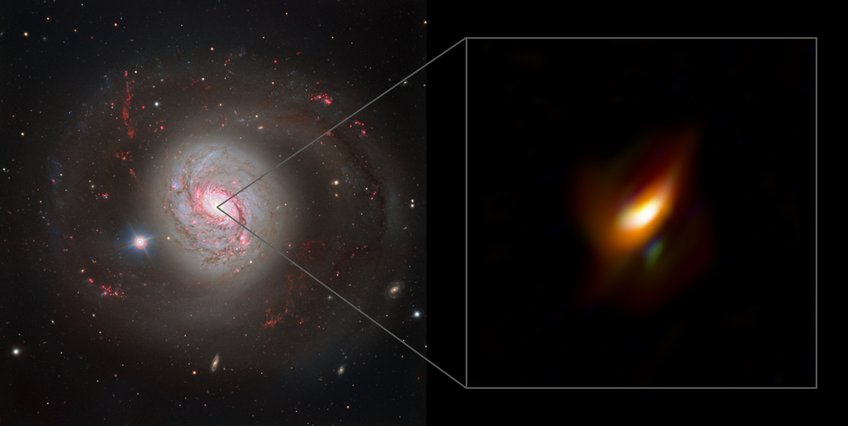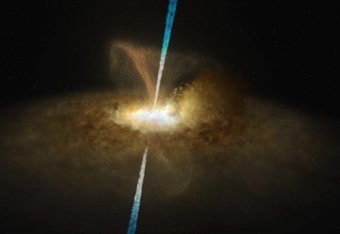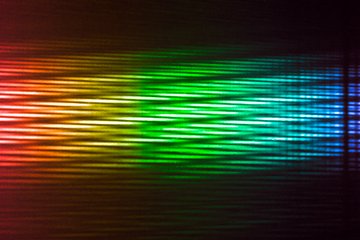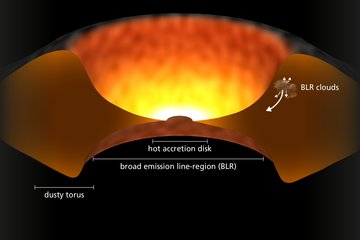Ring of cosmic dust hides a supermassive black hole in Active Galactic Nucleus
Image of warm dust emission from the heart of an active galactic nucleus shows a ring-like structure that obscures the black hole
Using ESO’s Very Large Telescope Interferometer (VLTI), a group of astronomers have observed cosmic dust at the centre of the Messier 77 galaxy hiding an active supermassive black hole. With essential contributions from scientists at the Max Planck Institute for Astronomy (MPIA), the collaboration’s findings confirm predictions concerning the nature of active galactic nuclei (AGN), some of the brightest and most enigmatic objects in the Universe, made around 30 years ago. These predictions favour a model that explains the observational features varying between AGN as the effect of different viewing angles on the same basic configuration.
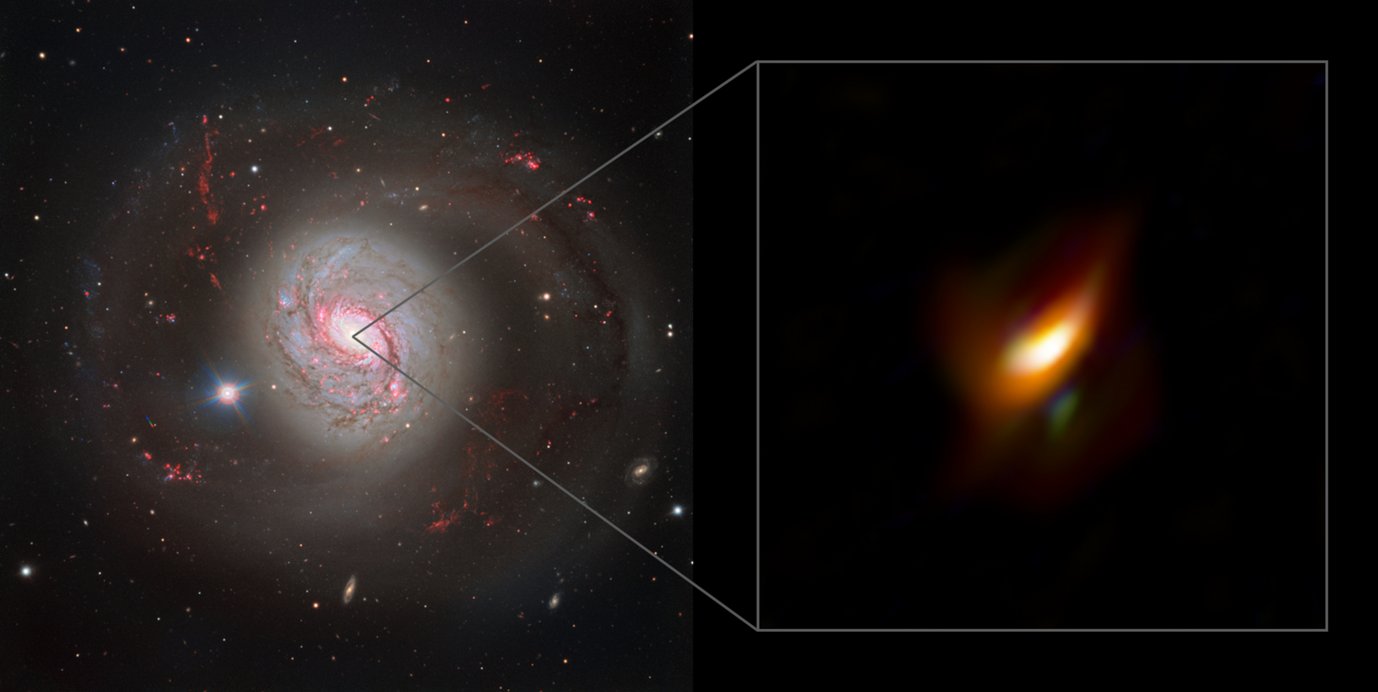
Using ESO’s Very Large Telescope Interferometer (VLTI), a group of astronomers have observed cosmic dust at the centre of the Messier 77 galaxy hiding an active supermassive black hole. With essential contributions from scientists at the Max Planck Institute for Astronomy (MPIA), the collaboration’s findings confirm predictions concerning the nature of active galactic nuclei (AGN), some of the brightest and most enigmatic objects in the Universe, made around 30 years ago. These predictions favour a model that explains the observational features varying between AGN as the effect of different viewing angles on the same basic configuration.
Active galactic nuclei (AGN) are extremely energetic sources powered by supermassive black holes and found at the centre of certain galaxies. These black holes consume large volumes of cosmic dust and gas. As it is eaten up, this material spirals towards the black hole and vast amounts of energy are released in the process, often outshining all the stars in the galaxy.
Astronomers have been curious about AGN ever since they first spotted these bright objects in the 1950s. Now, thanks to the VLTI of the European Southern Observatory (ESO), a team of researchers led by Violeta Gámez Rosas, from Leiden University in the Netherlands, with scientists from the Max Planck Institute for Astronomy (MPIA) have taken a critical step towards understanding how they work and what they look like up close. The results are published today in Nature.
By making extraordinarily detailed observations of the centre of the galaxy Messier 77, also known as NGC 1068, the team detected a thick ring of cosmic dust and gas hiding a supermassive black hole. This discovery provides vital evidence to support a 30-year-old theory known as the Unified Model of AGN.
Astronomers know there are different types of AGN. For example, some release strong bursts of radio waves while others are quiescent. Certain AGN shine brightly in visible light, while others, like Messier 77, are more subdued. The Unified Model states that despite their differences, all AGNs have the same basic structure: a supermassive black hole surrounded by a thick ring of dust.
According to this model, differences in appearance between AGN may result from the orientation at which we view the partially obscured central black from Earth. The type of AGN we see depends on how much the ring obscures the black hole from our viewpoint, completely hiding it in some cases.
Astronomers had found some evidence to support the Unified Model before, including spotting warm dust at the centre of Messier 77. However, doubts remained about whether this dust could fully hide a black hole and, hence, explain why this AGN shines less brightly in visible light than others. By pinpointing the black hole’s location and studying the structure of the dust ring around it in detail, astronomers have found proof that the ring completely obscures the black hole, as predicted by the Unified Model.
“The real nature of the dust clouds and their role in both feeding the black hole and determining how it looks when viewed from Earth have been central questions in AGN studies over the last three decades,” explains Gámez Rosas. “While no single result will settle all the questions we have, we have taken a major step in understanding how AGN work.”
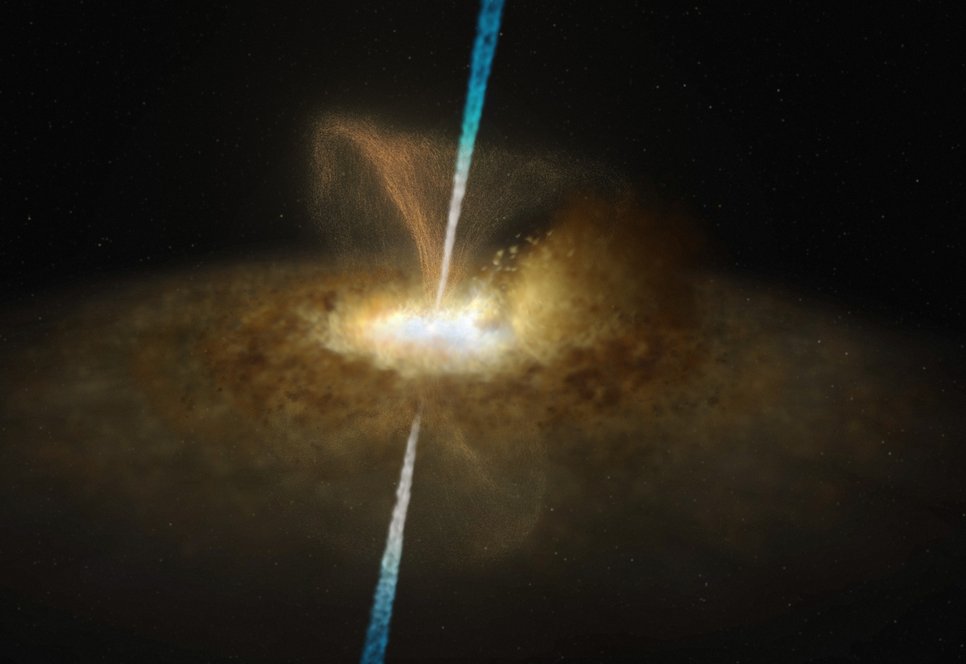
The observations were made possible thanks to the Multi AperTure mid-Infrared SpectroScopic Experiment (MATISSE) mounted on ESO’s VLTI, located in Chile’s Atacama Desert. MATISSE combined infrared light collected by all four 8.2-metre telescopes of ESO’s Very Large Telescope (VLT) using a technique called interferometry. The team used MATISSE to scan the centre of Messier 77, located 47 million light-years away in the constellation Cetus, at different wavelengths to build up a detailed picture of the ring of dust.
MPIA’s Jacob Isbell, the second author of the underlying publication, led critical activities of the image analysis of these new interferometric data. He adds, “Now we have all tools at hand to study the AGN phenomenon at unprecedented spatial detail.”
Thomas Henning, co-author and director of MPIA, points out, “The Max Planck Institute for Astronomy played a major role in constructing the MATISSE instrument. Now, it allows us for the first time to obtain images in the thermal infrared with a spatial resolution that is a factor of 10 higher than was previously possible. This improved performance was crucial in confirming the previous assumption that a dust torus indeed surrounds the AGN of Messier 77.”
Combining the changes in dust temperature (from around room temperature to about 1200 °C) caused by the intense radiation from the black hole with the absorption maps, the team built up a detailed picture of the dust and pinpointed where the black hole must lie. In a thick inner ring and a more extended disc, the dust with the black hole positioned at its centre supports the Unified Model. The team also used data from the Atacama Large Millimeter/submillimeter Array (ALMA) and the National Radio Astronomy Observatory’s Very Long Baseline Array to construct their picture.
Klaus Meisenheimer, who led MATISSE construction works at MPIA, adds, “Resolving the dust distribution in the cores of nearby active galaxies was my decade-long dream that finally became true with building MATISSE.” The entire MPIA team, including co-author Jörg-Uwe Pott, is currently exploring several more such AGN to constrain the dust morphology of these enigmatic sources systematically.
“Our results should lead to a better understanding of the inner workings of AGN,” concludes Gámez Rosas. “They could also help us better understand the history of the Milky Way, which harbours a supermassive black hole at its centre that may have been active in the past.”
The researchers are now looking to use ESO’s VLTI to find more supporting evidence of the Unified Model of AGNs by considering a larger sample of galaxies. ESO’s Extremely Large Telescope (ELT), set to begin observing later this decade, will also aid the search. It will provide results that will complement the team’s findings and allow them to explore the interaction between AGNs and galaxies.
Additional information
The team is composed of Violeta Gámez Rosas (Leiden Observatory, Leiden University, Netherlands [Leiden]), Jacob W. Isbell (Max Planck Institute for Astronomy, Heidelberg, Germany [MPIA]), Walter Jaffe (Leiden), Romain G. Petrov (Université Côte d’Azur, Observatoire de la Côte d’Azur, CNRS, Laboratoire Lagrange, France [OCA]), James H. Leftley (OCA), Karl-Heinz Hofmann (Max Planck Institute for Radio Astronomy, Bonn, Germany [MPIfR]), Florentin Millour (OCA), Leonard Burtscher (Leiden), Klaus Meisenheimer (MPIA), Anthony Meilland (OCA), Laurens B.F.M. Waters (Department of Astrophysics/IMAPP, Radboud University, the Netherlands; SRON, Netherlands Institute for Space Research, the Netherlands), Bruno Lopez (OCA), Stéphane Lagarde (OCA), Gerd Weigelt (MPIfR), Philippe Berio (OCA), Fatme Allouche (OCA), Sylvie Robbe-Dubois (OCA), Pierre Cruzalèbes (OCA), Felix Bettonvil (ASTRON, Dwingeloo, the Netherlands [ASTRON]), Thomas Henning (MPIA), Jean-Charles Augereau (Univ. Grenoble Alpes, CNRS, Institute for Planetary sciences and Astrophysics, France [IPAG]), Pierre Antonelli (OCA), Udo Beckmann (MPIfR), Roy van Boekel (MPIA), Philippe Bendjoya (OCA), William C. Danchi (NASA Goddard Space Flight Center, Greenbelt, USA), Carsten Dominik (Anton Pannekoek Institute for Astronomy, University of Amsterdam, The Netherlands [API]), Julien Drevon (OCA), Jack F. Gallimore (Department of Physics and Astronomy, Bucknell University, Lewisburg, Pennsylvania, USA), Uwe Graser (MPIA), Matthias Heininger (MPIfR), Vincent Hocdé (OCA), Michiel Hogerheijde (Leiden; API), Josef Hron (Department of Astrophysics, University of Vienna, Austria), Caterina M.V. Impellizzeri (Leiden), Lucia Klarmann (MPIA), Elena Kokoulina (OCA), Lucas Labadie (1st Institute of Physics, University of Cologne, Germany), Michael Lehmitz (MPIA), Alexis Matter (OCA), Claudia Paladini (European Southern Observatory, Santiago, Chile [ESO-Chile]), Eric Pantin (Centre d'Etudes de Saclay, Gif-sur-Yvette, France), Jörg-Uwe Pott (MPIA), Dieter Schertl (MPIfR), Anthony Soulain (Sydney Institute for Astronomy, University of Sydney, Australia [SIfA]), Philippe Stee (OCA), Konrad Tristram (ESO-Chile), Jozsef Varga (Leiden), Julien Woillez (European Southern Observatory, Garching bei München, Germany [ESO]), Sebastian Wolf (Institute for Theoretical Physics and Astrophysics, University of Kiel, Germany), Gideon Yoffe (MPIA), and Gerard Zins (ESO-Chile).
This press release is an adaptation of the version published by the European Southern Observatory.
